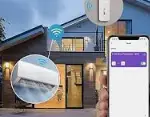
Aplicaciones Biomédicas para Arduino/Netduino/Raspberry
El Sensor Shield e-Salud permite que usuarios de Arduino y Raspberry Pi para realizar aplicaciones biométricas y médica donde se necesita supervisión cuerpo mediante el uso de diferentes sensores 9: pulso, el oxígeno en la sangre (SpO2), flujo de aire (respiración), la temperatura corporal, electrocardiograma (ECG) , glucómetro, la respuesta galvánica de la piel (GSR…

